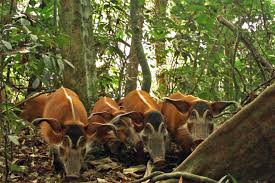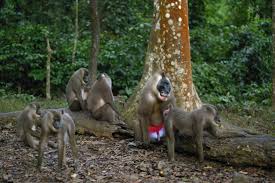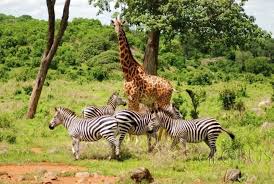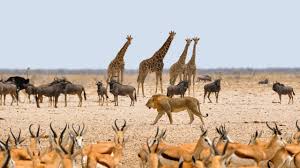In this article, the meaning of wildlife, development of wildlife in Nigeria, economic importance of wildlife, problems of wildlife management, and factors that cause extinction of wildlife will be discussed.
Definition of Wildlife Management
Wildlife is defined as animals or plants that exist in a wild, domesticated state, while wildlife management is the science and art of changing the characteristics and interactions of habitat, wild animals, and humans in order to achieve specific human goals using wildlife resources.
Wildlife Development in Nigeria
For hundreds of thousands of years, humans functioned as food gatherers, feeding omnivorously on what was most easily available. Over time, effective hunting techniques were developed, particularly during the later part of the Old Stone Age.
During the food gathering and hunting phases of his existence, man regarded wildlife as something of supreme importance. It was significant for energy, as a competitor, and as a principal source of food.
As animals were first domesticated, they took on new importance for humans. The dog was the first species to be brought under human care, following humans to the ends of the earth.
As man adopted a more settled way of life, the pig and domestic fowl were added to his collection of animal associates. Later, with the development of agriculture, wild beasts such as cows, sheep, goats, horses, and donkeys were domesticated.
Read Also: Amazon Flowers: All You Need To Know About
Concept of Wildlife Conservation

With agriculture and domesticated animals, human interaction with wild creatures changed. Village gardens and croplands needed protection from the raids of hungry herbivores. Vulnerable livestock needed guarding against the attacks of wolves and lions.
Herds of sheep and cattle had to find grazing grounds not already consumed by the feeding of other herds. Thus, wildlife assumed a different role. Predators regained their position as enemies, while deer and antelope, formerly valued as a food source, became threats to crops and grazing areas. Hunting thus assumed a new importance in human life.
With the rise of civilization, not all humans lived as hunters or herders. The leisure of kings or emperors and their noble courts, free from the need to work for a living, sought ways to occupy their time.
The old, primitive sport of hunting became a popular outlet for excess energy. To protect their hunting grounds, reserves were set aside, and certain animals were designated as royal game, which commoners were prohibited from hunting.
Wildlife conservation, therefore, began as a royal activity, but in recent years, sovereign nations have assumed full responsibility for wildlife management as a public concern.
History of Wildlife Development in Nigeria
It was not until the last four decades that pre-independence governments initiated programs for the conservation, management, and rational utilization of wildlife. By 1932, the Fauna Preservation Society of London (FPS) had allocated resources to Nigeria to establish some reserves.
In 1956, the first and most developed game reserve in Nigeria, Yankari, was demarcated in the Sudan vegetation zone of the then Northern Region. In the same year, the Borgu Game Reserve was surveyed in the Northern Guinea Savannah Vegetation zone. By 1962, Yankari Game Reserve had opened to tourists, while Borgu Game Reserve remained closed until 1970.
In 1975, the Kainji Lake National Park was created by a Federal Military Government decree. The park consists of the portion formerly known as the Borgu Game Reserve to the West of Lake Kainji, and the Zugurma Game Reserve on the eastern bank of the River Niger, below the Kainji Dam site.
The number of game reserves in Nigeria grew steadily, from two in 1962 to ten in 1961, and to thirty-six by 1975. The University of Ibadan introduced a degree program in Wildlife Management, and the Wildlife Management School in New Bussa commenced operations in 1980.
Local Parks and Game Reserves in Nigeria
| Park | State |
|---|---|
| Kainji Lake (Borgu) | Niger |
| Kanuku | Kaduna |
| Obundu | Cross River |
| Yankari | Bauchi |
| Orle River | Delta |
| Gilliugilli | Edo |
| Kovale | Edo |
| Kwatambana | Sokoto |
| Klewa | Niger |
| Bagidda | Niger |
| Onyra | Oyo |
| ——— | Plateau |
Concerns for Wild Creatures

Some individuals can live without wild creatures, while others cannot. The study of wildlife is essential for those who cannot live without it, as no other reason is sufficient for pursuing wildlife biology.
Attitudes toward wildlife range from active interest to complete indifference. Indifference is common among those who live and work in environments that rarely contact wild places, such as cities.
Active interest in wildlife is found among those who consider wild life and nature crucial to their own welfare. Such attitudes can be fostered through exposure to wild environments, family tradition, education, and travel.
Economic Importance of Wildlife
1. Meat Production: Wildlife constitutes a significant source of animal protein for people in rural areas of Nigeria. In southern Nigeria, nearly 20% of all locally produced animal protein came from wildlife in 1979. This demonstrates the importance of wildlife as a food source.
2.Tourism and Foreign Exchange: Wildlife reserves are among the world’s greatest attractions for tourists. Revenue is generated through international and local air transport, hotel bills, vehicle rentals, game guides, interpreters, and the sale of locally made souvenirs.
Currently, Yankari Game Reserve and Kainji Lake National Park attract over 10,000 and 3,000 fee-paying tourists per year, respectively, excluding non-fee paying nationals like students, children, societies, and dignitaries.
3. Aesthetic and Ethical Values: The recreational value of wildlife comes in many forms, with the aesthetic appeal of wildlife often attracting visitors to national parks and reserves. While hunting is prohibited, millions of people visit these parks to see and photograph wild animals in their natural surroundings. Even if wildlife had no economic value, it would still be worth preserving for its sheer beauty and its appeal to the human spirit.
4. Sale of Live Animals and Wild Animal Products: The exportation of wild animals for laboratory use amounted to millions of Naira in the 1960s. Additionally, wild animal products like the skins of reptiles, mammals (including leopards and antelope), and ivory from elephants are valuable exports.
5. Scientific Values: Wildlife plays a significant role in biological and medical research. For example, studies of rhesus monkeys have led to new discoveries about human blood chemistry and disease prevention. Similarly, studies of animal behavior have provided insights into human psychology.
The Concept of Ecosystem
An ecosystem consists of interdependent organisms living in a particular place, such as a forest or pond. A community within an ecosystem consists of various species, and each species has a population.
The relationships between these species and their environment are described as an ecosystem. An ecosystem includes producers, consumers, decomposers, and the physical environment such as soil, water, and air, as well as nutrient circulation.
Energy Flow in an Ecosystem
The primary energy source for an ecosystem is sunlight. Producers, such as plants, algae, and certain bacteria, convert this radiant energy into chemical energy through photosynthesis.
This energy is then transferred through the food chain to consumers (herbivores, carnivores, and omnivores) and decomposers. Energy moves non-cyclically, while nutrients, such as carbon, nitrogen, and oxygen, cycle through the ecosystem.
In the feeding chain, energy diminishes at each trophic level, but nutrients are recycled through decomposers and returned to the environment for reuse.
Animal Adaptation
Animal adaptation refers to the physiological, anatomical, and behavioral changes that help an organism survive in its specific environment. These adaptations improve the organism’s chances of surviving, reproducing, and passing on its genetic material.
Each species of plants and animals is generally suited to a particular environment, and they thrive under specific conditions. However, these organisms may struggle to survive if moved to an environment that differs significantly from their native habitat.
Adaptations help them adjust to environmental factors such as temperature, food availability, and predators, ensuring their survival and reproduction.
1. Factors Influencing Adaptation
i. Genetic Factors: Environmental changes, whether sudden (such as droughts, storms, or fires) or gradual (like climate change or soil erosion), can challenge the survival of organisms. In response, they may either migrate to more suitable areas or undergo adaptation processes.
If an organism is not well-suited to its current environment, it may not survive. Over time, beneficial genetic variations may emerge, giving organisms a better chance of survival. These beneficial traits can be passed on to future generations, gradually shaping the population to better adapt to environmental changes.
ii. Variation and Environmental Change: As environments change, certain genetic variations can give organisms an advantage. Some variations may enhance survival, leading to the spread of beneficial traits across a population.
This process of genetic recombination, aided by interbreeding between different populations, results in new gene combinations that may better suit the organism to the changing environment.
iii. Anatomical and Physiological Adaptations: Adaptations also include physical changes to an organism’s structure or internal processes. For example, some animals are able to adjust their food and energy needs during periods when resources are scarce.
Many animals, such as those in cold climates, develop extra layers of fat or thick fur to conserve heat. Similarly, certain species have adapted specialized teeth or stomachs to consume specific types of food, minimizing competition with other animals for resources.
iv. Locomotion and Movement Adaptations: Animals have different adaptations to help them move efficiently. For example, some species are fast movers, while others are slower but more efficient in their movement.
The design of an animal’s limbs affects its speed. In animals like horses, the digitigrade posture allows for faster movement. Other animals, like the bear, move more slowly due to their plantigrade posture, walking flat-footed.
Read Also: Pumpkin Flowers (Pumpkin Blossoms): Complete Growing and Care Guide
Problems of Wildlife Management in Nigeria

- Unregulated hunting and trapping of wild animals
- Illegal grazing by Fulani herdsmen
- Lack of skilled manpower (trained personnel for wildlife conservation)
- Inadequate funding for game reserves and wildlife parks
- Risk to the lives of staff working in conservation areas
- Inadequate jeep tracks or access roads within game reserves
- Use of toxic chemicals by farmers or residents near wildlife areas to kill animals
- Lack of empathy towards wildlife conservation efforts
Factors Causing Extinction of Wildlife
- Encroachment on wildlife habitats by human settlements
- Breaking game laws, particularly by hunters
- Chemical pollution, particularly in aquatic habitats
- Natural disasters such as droughts, floods, and fires
- Overhunting and overtrapping by humans
- Predation by carnivorous animals
- Increased settlement and human population growth leading to habitat destruction
- Deforestation due to human activities reducing space for wildlife habitats
- Poor management of game reserves due to political instability or maladministration
Do you have any questions, suggestions, or contributions? If so, please feel free to use the comment box below to share your thoughts. We also encourage you to kindly share this information with others who might benefit from it. Since we can’t reach everyone at once, we truly appreciate your help in spreading the word. Thank you so much for your support and for sharing!

